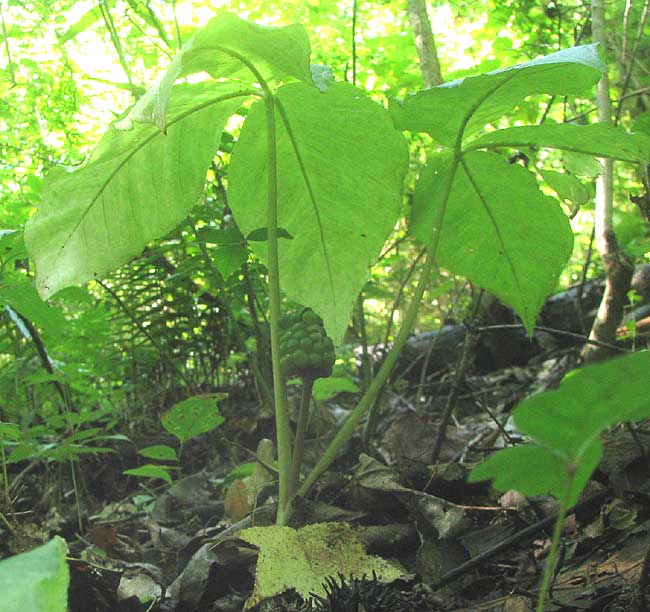Excerpts from Jim Conrad's
Naturalist Newsletter

from the the August 5, 2012 Newsletter issued from the woods of the Loess Hill Region a few miles east of Natchez, Mississippi, USA
JACK-IN-THE-PULPIT IN AUGUST
Jack-in-the-pulpit, ARISAEMA TRIPHYLLUM, is one of eastern North America's best-loved and most recognizable wildflowers. It gets attention in early spring when its unusual spike of flowers, or "spadix," (the "Jack") arises inside a hooded cylinder of leafy tissue referred to as the "spathe," (the pulpit). Woods walkers in late fall also notice its clusters of bright red, pea-sized fruits on dead stems attached to brown, frost-killed leaves, though often they don't realize that these are Jack-in-the-pulpit fruits. Nowadays in midsummer's sublimely green, lush forest those fruits are serenely and inconspicuously maturing, already fairly large but still hard and green, as shown nicely green-camouflaged on a fruiting stem from which the pulpit-like spathe has fallen away, and which arises between two trifoliate leaves bove.
A close-up of the fruits, which botanically are berries (fleshy fruits not splitting at maturity and bearing more than one seed), is shown below:

Another name for Jack-in-the-pulpit is "Indian Turnip." Indigenous Americans did make flour from the ground and water-leached corm, and they cooked it and ate it. As a kid back in Kentucky, one cold, bright spring morning after I'd read that I decided to see what the corm tasted like without bothering to ground, leach or cook it. I simply sliced off a piece from a freshly dug root and tossed it into my mouth.
In my entire life I have never experienced such a jolt of pain from anything put into my mouth. For several minutes I coughed and spit and was sure that at any moment I'd die. Hot, twisting needles inserted into my tongue would not have hurt more. I was experiencing the effects of the tiny calcium oxalate crystals Mother Nature put into Jack-in-the-pulpit corms to keep moles and such from nibbling them.
Despite the fact that these crystals can be destroyed or removed by drying, leaching, roasting and cooking, it would be a shame to do this, for several wildflowers would have to be sacrificed just for a rather bland mouthful or two.
Medicinally, Jack-in-the-pulpit's acid-filled tubers have been used in such varied ways that you wonder if any are really very useful. One interesting-sounding use reported of indigenous Americans was to grind the raw corm and mix with lard to be smeared on ringworm infections. Other treatments have been documented for use against arthritis, asthma, bronchitis, stomachache, gas and headache, and for use as an insecticide.
Jack-in-the-pulpit is a member of the same large, predominantly tropical family as philodendrons, callas, caladiums and the enormous-leafed elephant ears outside my hut in the Yucatan. It's the Arum Family, or Araceae. You can think of Jack-in-the-pulpit as an unusual Temperate Zone fringe element of that heat- and moisture-loving family. The basic Jack-in-the-pulpit flower structure -- many tiny flowers covering a spiky spathe attended by a leafy, often enveloping sheath -- is typical in that family.